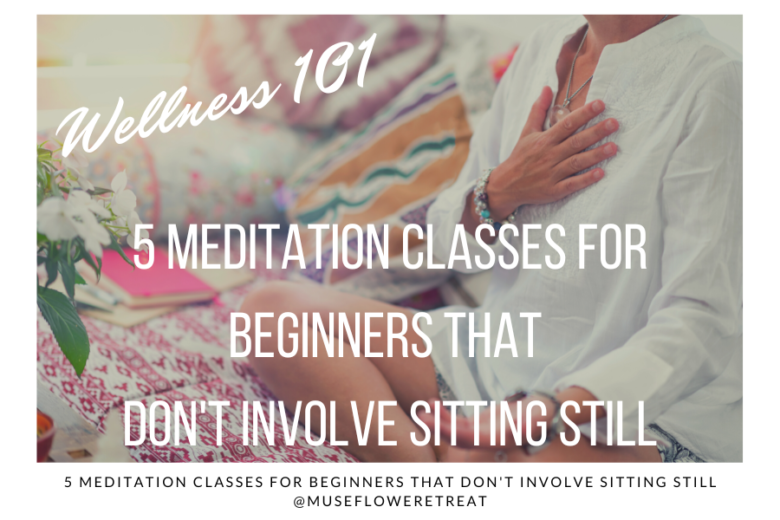Recently a guest asked me what type of meditation classes are suitable for an absolute beginner like him.
My first response was this: try out different styles of meditation!
Finding a meditation style that works for you is very similar to finding a compatible life partner.
After all, you are building a regular and hopefully life-long meditation practice to reap all its amazing benefits, including lowering stress and anxiety, calming nervous system, living more consciously, etc.
When one style of meditation doesn’t work for you (whatever that means for you as this depends on what you think meditation can help you with at the first place), it doesn’t mean that you cannot meditate. It just means you haven’t found the right practice that really lands for you, just yet.
When I first tried out meditation, I always thought that I had to sit still with my back straight, cross-legged, and to focus on my breathing and empty my thoughts. It didn’t work. I could hardly sit still for more than a minute without my back aching. And nope, my monkey mind did not calm down at all.
So I gave up. I thought meditation wasn’t for me, or worse – I was crap at meditating so I better stopped trying.
Then I realized that sitting still was only one style of meditation. What a relief!
Below are a few different styles of meditation that I have experienced in the past that are absolutely suitable for beginners and do not involve sitting still for an extended period of time.
If one style doesn’t work for you, remember – it doesn’t mean that meditation is not for you. It just means that one style doesn’t resonate with you – now. It may, in the future.
It’s important to find a practice that meets where you are right now.
And you will be surprised! The more you practice with one style, other styles of meditation will start to feel easier, even when you have to sit still.
1. If you can’t sit still and want to move constantly, try…
Walking meditation in a labyrinth (or a finger labyrinth walk)

Labyrinths have been around since the stone age, and it is a perfect meditation practice that engages your body, mind, and all your senses.
In a labyrinth walk, you follow the path with your natural pace. A labyrinth only has one way in and one way out so you cannot get lost and your mind can naturally relax.
As you walk, you observe any thoughts, emotions, or body sensations that arise and allow them just be. When you reach to the center, allow yourself to receive whatever insights may come. Anything that draws your attention or happens during the walk can be a metaphor in your life. Pay attention to what unfolds and make sure to take some time afterwards to process, using tools like journaling, drawing, coloring, and sharing in a group.
2. If you are too self-conscious to dance in front of others but secretly love to dance, try…
Moving meditation with intuitive dancing

Intuitive dance or any moving meditation does not require us to follow certain movements or choreography. Instead, we are asked to tune into our body and listen to how our body wants to express itself.
Usually the facilitator will select a variety of songs with different beats and rhythms to move with. Even if there are other people around, we are asked to focus solely on our movements.
This is a great practice to help get out of our headspace, and as we dance, some emotions or feelings may arise which are okay. Emotions are energies in motion, and as we move, energies will get unstuck.
During the process, we can observe everything that is going on internally and at the same time, allow and give space for what wants to arise and eventually passes through. Some intuitive dance modalities that I know of include DanceMandala, JourneyDance, Biodanza, and Ecstatic Dance.
3. If you enjoy singing in the shower or in the car (or both), try…
Chanting meditation practice with mantra

Chanting meditation uses sounds to help us align with a certain frequency and harmonize our energy. When we are repeating a certain mantra, it gives our mind something to focus on and eventually relaxes. The mantra also serves as an anchor to bring our awareness back to the present moment whenever the mind wanders off.
The vibration of each mantra helps to invoke a certain quality, such as creativity, courage and love. When we get to sing the mantras, it is a fun and light-hearted way to express our voice. Besides, singing is a natural anti-depressant, who doesn’t love that?
4. If you are a visual learner and can’t focus only on breathing, try…
Visualization meditation using imagery

For those who are visual learners and love a good image, visualization can help the mind focus and evoke a certain sensation or emotion, such as calm, inner peace, joy, etc.
When I began my meditation practice, I could hardly focus on counting breaths. Visualizing an image, such as imagining myself as a tree with roots growing under my feet, help me feel grounded, and stay longer and more focused in a meditative state.
Bonus – you can do this lying down or anywhere you are, so why not?

For some people, the intention of meditation is to create space and stillness in the mind in order to receive spiritual guidance. Shamanic journeying is not really like a traditional mindfulness meditation where we observe our thoughts. In Shamanic journeying, we allow our imagination and intuition to guide us on a soul journey, very much like a dream, to meet with our power animals and spirit guides to ask for direct guidance or healing.
One thing I love about Shamanic journeying when I first learned about it was that I could lie down for the entire time! No more sitting up straight and being distracted by my back pain.
Sometimes we use eye covers so the darkness can help us go even deeper into the journey. It is possible to fall asleep in a Shamanic journey though, but in that case I always tell people that this is what their body needs at the moment and it is perfectly okay. Who doesn’t need a nap once in a while?
Here at Museflower Retreat & Spa, we offer different meditation classes for our guests to explore such as mindfulness meditation, visualization meditation, movement meditation, mantra meditation, kirtan, Shamanic journeying, and labyrinth walks.
For those who are looking to build a regular meditation practice at home, I also offer a workshop called “Your Superpower No. 1: Meditation – Find What Works for You” where we try out a few simple meditation techniques, and come up with a practical plan together to kickstart your practice at home.
I always recommend our guests who are beginners in meditation to try out different styles and see which one they resonate with. For more information about our meditation classes, check out our class descriptions here.
You can also check out my previous blogs on meditation tips, such as “5 Practical Tips to Help You Meditate Regularly” and “Get Started with Your First Superpower – Meditation” to help you get started on your meditation journey.
If you have any questions about how to get started with meditation at home, or what types of meditation classes you should try when you are at Museflower, I’ll be happy to help. Feel free to reach out to me directly here.




